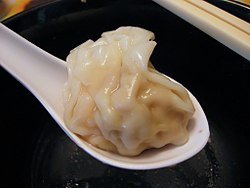Wonton
 Wonton
WontonA wonton (also spelled wantan, wanton, or wuntun in transcription from Cantonese; Mandarin: húndun or húntun) is a type of dumpling commonly found in a number of Chinese cuisines.
Wontons are made by spreading a square wrapper (a dough skin made of flour, egg, water, and salt) flat in the palm of one's hand, placing a small amount of filling in the center, and sealing the wonton into the desired shape by compressing the wrapper's edges together with the fingers. Adhesion may be improved by moistening the wrapper's inner edges, typically by dipping a fingertip into water and running it across the dry dough to dissolve the extra flour. As part of the sealing process, air is pressed out of the interior to avoid rupturing the wonton from internal pressure when cooked.
The most common filling is ground pork and shrimp with a small amount of flour added as a binder. The mixture is seasoned with salt, spices, and often garlic or finely chopped green onion. Factory-made, frozen varieties are sold in supermarkets. Commonly, they are handmade at the point of sale in markets or small restaurants by the proprietor while awaiting customers. In markets, they are sold by the unit, without being pre-cooked.
Wontons are commonly boiled and served in soup or sometimes deep-fried. There are several common regional variations of shape.
The most versatile shape is a simple right triangle, made by folding the square wrapper in half by pulling together two diagonally opposite corners. Its flat profile allows it to be pan-fried like a guotie (pot sticker) in addition to being boiled or deep-fried.
A more globular wonton can be formed by folding all four corners together, resulting in a shape reminiscent of a stereotypical hobo's bindle made by tying all four corners of a cloth together.
A related kind of wonton is made by using the same kind of wrapper, but applying only a minute amount of filling (frequently meat) and quickly closing the wrapper-holding hand, sealing the wonton into an unevenly squashed shape. These are called xiao huntun (literally "little wonton") and are invariably served in a soup, often with condiments such as pickles, ginger, sesame oil, and cilantro (coriander leaves).
...
Wikipedia